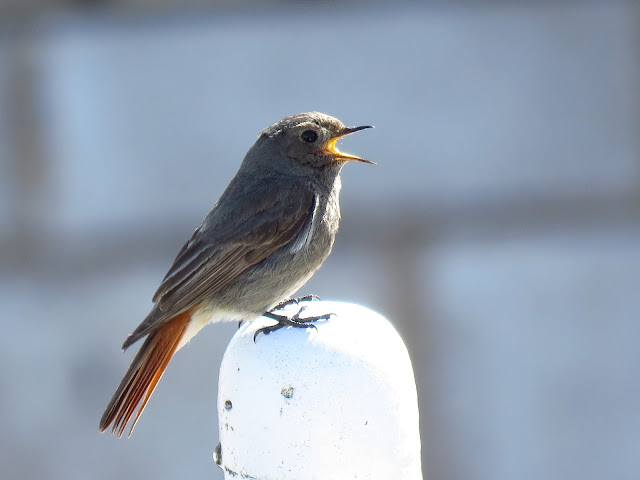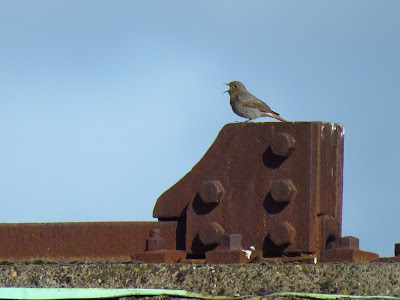
Black Redstarts are robin-sized birds. In all plumages the tail is brick red with darker central feathers. Adult males are slate grey, with coal black face and chest, with a white wing panel. Subadult males and females are greyer, with a plainer head and no wing panel. They are a scarce migrant, winter visitor, and rare breeding species in the UK. They have an unusual history as a UK breeding bird. The first record of breeding in the UK was in 1926 in the Wembley Exhibition Centre, London. It is a bird of uplands in rocky sites, slope screes and cliffs, all dry, exposed habitats with little vegetation cover. In the 1850s the species started to colonise urban environments across Western Europe, taking advantage of suitable nest sites in walls and buildings and abundant dry slopes in roofs offering enough feeding habitat. Today, Black Redstarts breeding habitats include cathedrals, museums, power stations, train stations, warehouses, dock depots, demolition sites, railway yards and industrial waste grounds, making this species a truly urban bird! Just a few territories are in coastal cliffs or quarries. Black Redstarts feed on small insects, woodlice and spiders that picks from the ground, seeds and berries. Towns and cities also provide suitable tall singing posts.
Distribution and status in Hull
As in other large cities in the UK, the Blitz of World War II created favourable habitat in Hull, and the Black Redstart colonised bombed sites. The first Hull record, a possible breeding pair and two males singing at High Street, were in 1949. The first confirmed breeding was in 1973 at a boat on a dry dock. It is an irregular rare breeder in Hull, but records of passage migrants are more frequent. Breeding was confirmed at Saltend in 1986. In the last 10 years they appear to have bred at the Hull docks. Given that their usual habitats are not regularly visited by birdwatchers, some pairs might have been missed. Sightings are from March to December. Black Redstarts tend to migrate south in winter, with a preference to winter at coastal sites.
Conservation
The Black Redstart is fully protected by the Schedule 1 of the Wildlife and Countryside Act 1981, therefore any disturbance to nests or near nests is illegal. There are currently less than 100 breeding pairs in the UK, with between one and four pairs breeding in Yorkshire in the last decade. After a spell as Red listed due to a breeding population declines, populations have recently increased that they are now Amber listed (Birds of Conservation Concern 5, 2021).
A migrating adult male Redstart at Kilnsea Wetlands, 31 October 2019.
Management
- Building Work. It should be avoided between March and July (inclusive), within 300 m of a suspected nest site. Singing males usually chose posts near nest sites.
- Provision of nest sites. These could include ledges on inner walls or integrated nests holes build onto walls.
- Maintenance of pioneer vegetation communities. Redevelopment often results in planting grassland, or trees and bushes, removing the open feeding habitats needed by Black Redstarts. The creation of green roofs on light aggregates on new or existing buildings might mitigate loses of suitable habitats, as it is difficult to recreate the mossy, lichen and light plant cover characterising its natural habitats. Alternatives would be to create gravelly gardens or a light cover of gravel on flat roofs, to be recolonised naturally.
- Retain wooden structures, including derelict boats, when redeveloping sea walls.
- Survey work. Protection of existing breeding pairs can only be achieved if their nesting sites and foraging areas are known. Potential breeding sites should be surveyed, with singing males, nesting pairs and successful breeding recorded. Any records during the breeding season should be submitted to local county bird recorders.
More information









2 comments:
Thank you for an interesting article. I used to see Black Redstarts on the abandoned factory sites in Birmingham in the 1990s, but most of these have now been built over. Amazingly, one turned up in the huge noisy Winter Wonderland funfair in Hyde Park in December 2017, flying in and out of the enclosure.
Thank you for your comment Ralph. It surprises me how rare the Black Redstarts are here. It is not the cold, as they winter in my hometown in central Spain where it gets very cold, there they are very common in urban settings, particularly parks and gardens. I have read that competition with Robins might limit their distribution here in the UK
Post a Comment